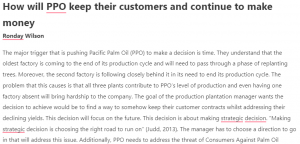How will PPO keep their customers and continue to make money

Ronday Wilson
The major trigger that is pushing Pacific Palm Oil (PPO) to make a decision is time. They understand that the oldest factory is coming to the end of its production cycle and will need to pass through a phase of replanting trees. Moreover, the second factory is following closely behind it in its need to end its production cycle. The problem that this causes is that all three plants contribute to PPO’s level of production and even having one factory absent will bring hardship to the company. The goal of the production plantation manager wants the decision to achieve would be to find a way to somehow keep their customer contracts whilst addressing their declining yields. This decision will focus on the future. This decision is about making strategic decision. “Making strategic decision is choosing the right road to run on” (Judd, 2013). The manager has to choose a direction to go in that will address this issue. Additionally, PPO needs to address the threat of Consumers Against Palm Oil (CAPO). If their decision does not address both the customer contracts and the CAPO then may have to address a separate issue for CAPO as this is a present threat. This present problem refers to managing operations. “Managing operations is running well on the chosen road.” (Judd, 2013). The protest have begun so PPO will have to figure out how to appease them while addressing the future problem too. Possible decision statement #1: The company will expand into another country. It will take time to choose another country, plant the trees and get a yield. Currently all three factories are producing. This is the perfect time to build a new factory in another county as the oldest factory will be out of commission in a few years. Possible decision statement #2: Palm oil will be imported from other countries. This would give the plantations time to replant a new crop, bring the destruction of the current rain forest to a halt, which would make both the orangutans and CAPO happy. “But to produce palm oil in large enough quantities to meet growing demand, farmers across Southeast Asia have been clearing huge swaths of biodiversity-rich tropical rain forest to make room for massive palm plantations” (Miniscalco, 2008, para. 2). Lastly, it would give the new outsourced location time to start producing. Importing may be expensive but the cost may be offset by the fact that PPO won’t have to pay for labor or taxes for the shutdown factory. The decision statement “In responding to CAPO’s attacks, how will PPO keep their customers and continue to make money?” focuses on the two main concerns of the company which are retaining customers and continuing to make money. This decision statement is valid as it lets you know that the company is being proactive and not reactive. Reactive decisions are made after an event has taken place. “Decisions are declared by human beings. Sometimes they arise when we have what philosophers call a break in our existence—some change in our circumstances— that impels us to declare a decision. We can consider these decisions as reactive to the change” (Howard & Abbas, 2015, p. 4, para. 6). This decision statement keeps the primary goals (customers and money) while ignoring the other such as the orangutans, deforestation and CAPO. My decisions are incorrect as they did the opposite.
Reference Howard, R. A. & Abbas, A. E. (2015, January 21). Foundations of Decision Analysis. Retrieved from http://create.usc.edu/sites/default/files/publications/m01howa624601sec01.pdf Judd, B. [Strategic Decisions Group] (2013, November 30). Fundamentals of Decision Quality. [Video file]. Retrieved from https://www.youtube.com/watch?v=dFV-lzIqfRA Miniscalco, E. (2008, December 11). Is Harvesting Palm Oil Destroying the Rainforests? Retrieved https://www.scientificamerican.com/article/harvesting-palm-oil-and-rainforests/